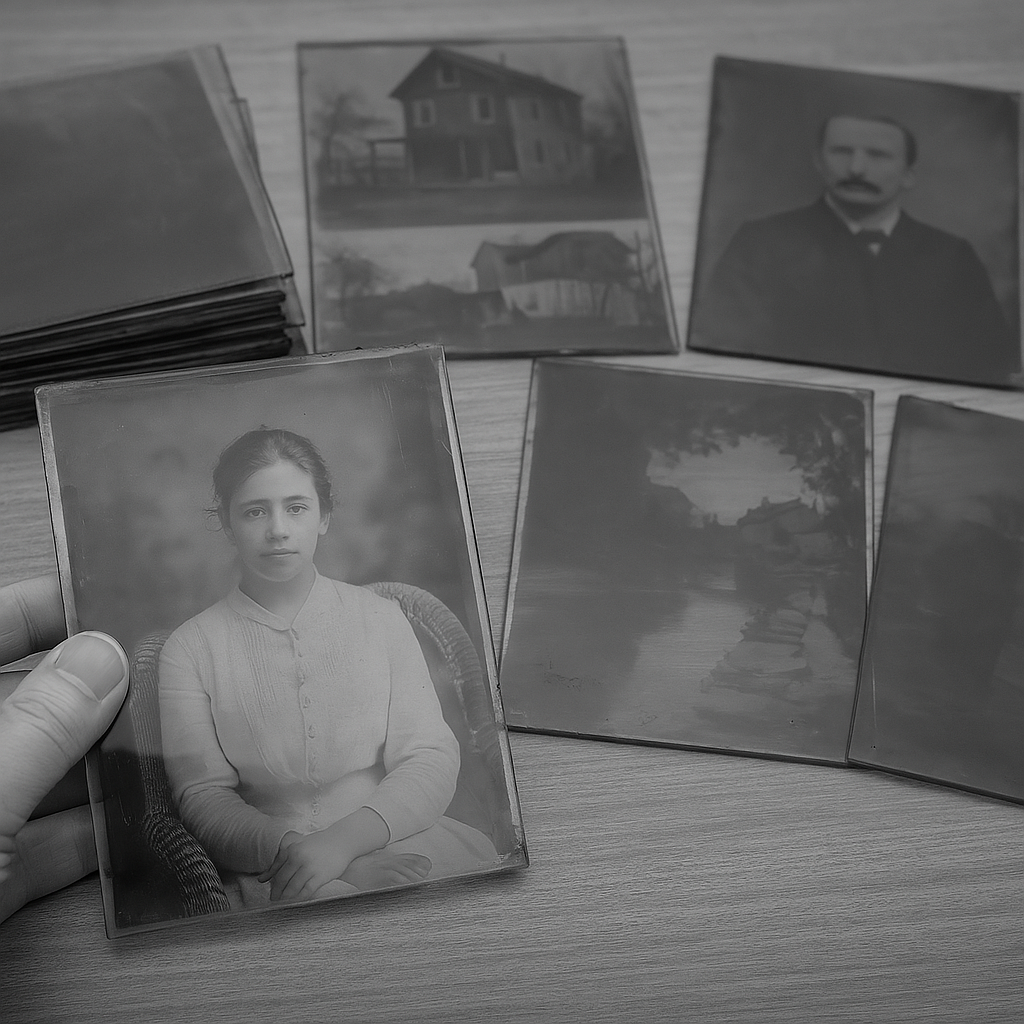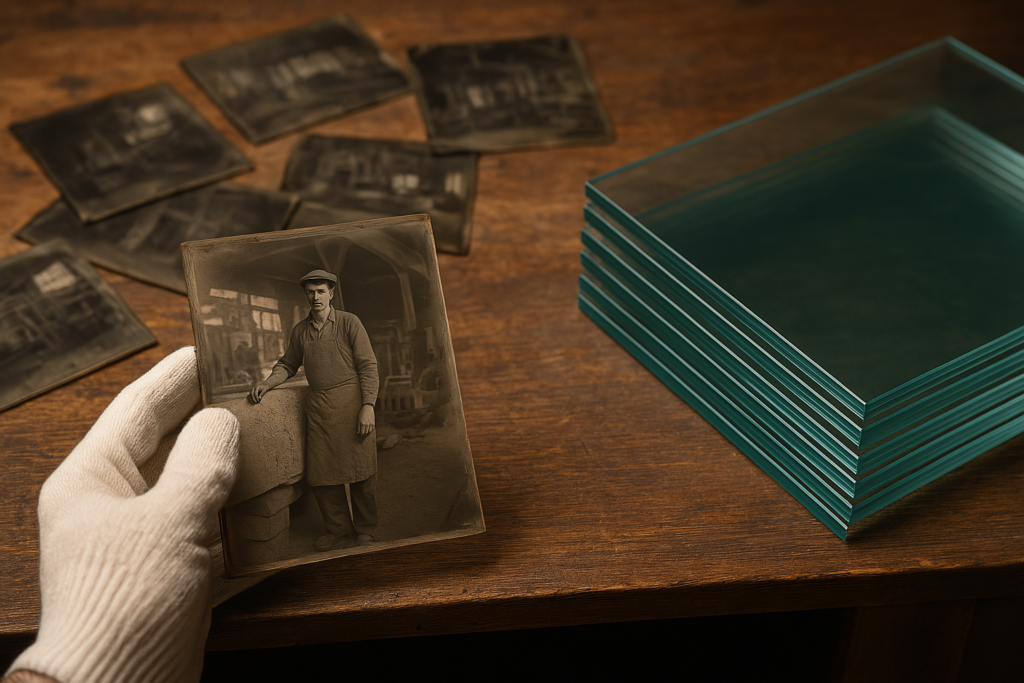Glass has played an indispensable role in technological and industrial advancements, influencing photography, architecture, and numerous other fields. Among various glass types, glass plate negatives and float glass hold significant historical and modern importance. In this article, we explore the intriguing history, manufacturing processes, and contemporary applications of both glass plate negatives and float glass.
What Are Glass Plate Negatives?
Glass plate negatives were among the earliest photographic mediums, predating film. This photographic technique involved applying a light-sensitive emulsion onto a transparent glass plate, capturing images with remarkable clarity and detail. Widely used in the late 19th and early 20th centuries, glass plate negatives significantly shaped the development of photography and historical documentation.

History of Glass Plate Negatives
The use of glass plate negatives dates back to the mid-1800s when Frederick Scott Archer introduced the wet plate collodion process. Photographers appreciated glass plates for their ability to provide exceptional sharpness and resolution. However, this method required immediate processing while still wet, demanding portable darkrooms.
By the late 19th century, the dry plate method emerged, simplifying photography by allowing plates to be prepared in advance, revolutionizing photography and expanding its reach.
How Glass Plate Negatives Are Created
Creating glass plate negatives involves several key steps:
- Preparation: Glass plates are thoroughly cleaned and coated with a gelatin-based emulsion containing silver halides.
- Exposure: The coated plate is placed in a camera, exposed to light, forming a latent image.
- Development: The plate is chemically developed, revealing the captured image.
- Fixing and Washing: A chemical fixer stabilizes the image, and the plate is washed to remove residual chemicals.
- Drying and Storage: Plates are carefully dried and stored to prevent damage and degradation.
Advantages and Limitations of Glass Plate Negatives
Advantages:
- Superior image clarity and resolution
- Greater durability compared to early film
- Ability to enlarge images without significant loss of detail
Limitations:
- Fragile and heavy, requiring careful handling and storage
- Labor-intensive and time-consuming production
- Less convenient compared to film photography
Float Glass: A Modern Innovation
While glass plate negatives represent historical photography, float glass represents modern innovation in manufacturing and construction. Developed by Sir Alastair Pilkington in the 1950s, float glass revolutionized glass production, delivering superior quality, uniformity, and versatility compared to earlier glass-making techniques.
The Float Glass Manufacture Process
Float glass manufacture is a precision-driven process involving the following steps:
- Batch Preparation: Raw materials such as silica sand, limestone, soda ash, and recycled glass are combined.
- Melting and Refining: These ingredients are heated to approximately 1,500°C in furnaces, forming molten glass.
- Float Bath: The molten glass floats across a bed of molten tin, resulting in a perfectly flat surface and uniform thickness.
- Annealing: Glass sheets pass through controlled cooling chambers to relieve internal stress.
- Inspection and Cutting: The sheets are cut into specified sizes, inspected for quality, and prepared for shipment.
Types and Applications of Float Glass
Float glass has various forms, including clear float glass, tinted glass, and reflective coatings. These types serve multiple applications:
- Architecture and Construction: Windows, façades, doors, partitions, and skylights
- Automotive Industry: Windshields, side windows, rear windows, mirrors
- Solar Panels: Specially produced float glass for solar photovoltaic modules
- Interior Design: Glass furniture, mirrors, decorative partitions, and shelves
Float Glass Industries in UAE & Mediterranean
The float glass industries in the UAE and Mediterranean regions are globally recognized for their advanced technology and production capabilities. Notable industry leaders include:
- Emirates Float Glass (EFG) in the UAE, known for advanced manufacturing practices and sustainable products.
- Mediterranean float glass companies such as Saint-Gobain, Guardian Glass, and Şişecam, offering high-quality, innovative glass solutions across Europe, North Africa, and the Middle East.
Comparing Glass Plate Negatives and Float Glass
Despite their distinctly different applications and time periods, glass plate negatives and float glass share common attributes related to their material properties and manufacturing precision.
Material Properties and Clarity
Both glass plate negatives and float glass are valued for their exceptional clarity. Glass plate negatives captured images with extraordinary detail, while modern float glass is prized for visual transparency and minimal distortion, essential in architectural and automotive applications.
Manufacturing Precision
Precision is crucial in both processes. Glass plate negatives require precise emulsion application and meticulous chemical handling. Similarly, float glass production demands accuracy in temperature control, raw material quality, and thickness consistency.
Applications and Historical Context
Glass plate negatives primarily served historical photographic purposes, archiving images of past eras. Conversely, float glass addresses contemporary needs, serving diverse industries from construction to renewable energy.
Proper Glass Installation Practices
Correct handling and installation practices ensure longevity and functionality, particularly critical with float glass applications.
Essential Tools and Tips for Successful Glass Installation
Professional glass installation requires specialized tools and techniques, including:
- Glass suction cups for safe handling
- Glazing tools and sealants for secure fitting
- Protective gear for safety during installation
Proper installation techniques help maintain the structural integrity and aesthetics of float glass installations.
Future Trends: Innovations in Float Glass and Photographic Preservation
Future advancements in float glass manufacture aim at enhancing sustainability, energy efficiency, and smart glass technologies. Simultaneously, efforts continue in preserving historical glass plate negatives, ensuring invaluable cultural and historical records endure for future generations.
Innovations in Float Glass
- Smart Glass Technologies: Incorporation of switchable glass that adjusts transparency electronically
- Solar Efficiency Improvements: Higher performance float glass for photovoltaic applications
- Eco-Friendly Production: Sustainable production practices reducing environmental impacts
Preservation of Glass Plate Negatives
- Digitization Projects: Digital archives created from original glass plates for broader access and preservation
- Advanced Storage Techniques: Improved preservation methods and protective environments to maintain original quality
Conclusion: Bridging History and Modernity Through Glass
Glass plate negatives and float glass exemplify the profound influence glass technology has had historically and continues to exert today. Understanding their distinct histories, production methods, and modern relevance underscores the enduring importance of glass as a material shaping human innovation.
Explore further into the world of float glass and delve deeper into mastering the art of professional glass installation to fully appreciate the scope and impact of glass technology across industries.

